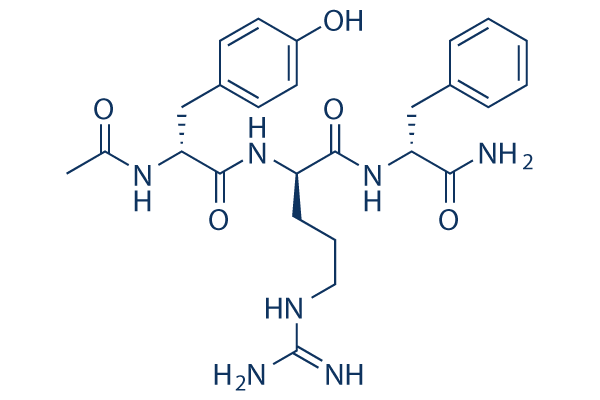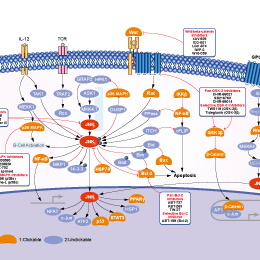
- Bioactive Compounds
- By Signaling Pathways
- PI3K/Akt/mTOR
- Epigenetics
- Methylation
- Immunology & Inflammation
- Protein Tyrosine Kinase
- Angiogenesis
- Apoptosis
- Autophagy
- ER stress & UPR
- JAK/STAT
- MAPK
- Cytoskeletal Signaling
- Cell Cycle
- TGF-beta/Smad
- DNA Damage/DNA Repair
- Compound Libraries
- Popular Compound Libraries
- Customize Library
- Clinical and FDA-approved Related
- Bioactive Compound Libraries
- Inhibitor Related
- Natural Product Related
- Metabolism Related
- Cell Death Related
- By Signaling Pathway
- By Disease
- Anti-infection and Antiviral Related
- Neuronal and Immunology Related
- Fragment and Covalent Related
- FDA-approved Drug Library
- FDA-approved & Passed Phase I Drug Library
- Preclinical/Clinical Compound Library
- Bioactive Compound Library-I
- Bioactive Compound Library-Ⅱ
- Kinase Inhibitor Library
- Express-Pick Library
- Natural Product Library
- Human Endogenous Metabolite Compound Library
- Alkaloid Compound LibraryNew
- Angiogenesis Related compound Library
- Anti-Aging Compound Library
- Anti-alzheimer Disease Compound Library
- Antibiotics compound Library
- Anti-cancer Compound Library
- Anti-cancer Compound Library-Ⅱ
- Anti-cancer Metabolism Compound Library
- Anti-Cardiovascular Disease Compound Library
- Anti-diabetic Compound Library
- Anti-infection Compound Library
- Antioxidant Compound Library
- Anti-parasitic Compound Library
- Antiviral Compound Library
- Apoptosis Compound Library
- Autophagy Compound Library
- Calcium Channel Blocker LibraryNew
- Cambridge Cancer Compound Library
- Carbohydrate Metabolism Compound LibraryNew
- Cell Cycle compound library
- CNS-Penetrant Compound Library
- Covalent Inhibitor Library
- Cytokine Inhibitor LibraryNew
- Cytoskeletal Signaling Pathway Compound Library
- DNA Damage/DNA Repair compound Library
- Drug-like Compound Library
- Endoplasmic Reticulum Stress Compound Library
- Epigenetics Compound Library
- Exosome Secretion Related Compound LibraryNew
- FDA-approved Anticancer Drug LibraryNew
- Ferroptosis Compound Library
- Flavonoid Compound Library
- Fragment Library
- Glutamine Metabolism Compound Library
- Glycolysis Compound Library
- GPCR Compound Library
- Gut Microbial Metabolite Library
- HIF-1 Signaling Pathway Compound Library
- Highly Selective Inhibitor Library
- Histone modification compound library
- HTS Library for Drug Discovery
- Human Hormone Related Compound LibraryNew
- Human Transcription Factor Compound LibraryNew
- Immunology/Inflammation Compound Library
- Inhibitor Library
- Ion Channel Ligand Library
- JAK/STAT compound library
- Lipid Metabolism Compound LibraryNew
- Macrocyclic Compound Library
- MAPK Inhibitor Library
- Medicine Food Homology Compound Library
- Metabolism Compound Library
- Methylation Compound Library
- Mouse Metabolite Compound LibraryNew
- Natural Organic Compound Library
- Neuronal Signaling Compound Library
- NF-κB Signaling Compound Library
- Nucleoside Analogue Library
- Obesity Compound Library
- Oxidative Stress Compound LibraryNew
- Plant Extract Library
- Phenotypic Screening Library
- PI3K/Akt Inhibitor Library
- Protease Inhibitor Library
- Protein-protein Interaction Inhibitor Library
- Pyroptosis Compound Library
- Small Molecule Immuno-Oncology Compound Library
- Mitochondria-Targeted Compound LibraryNew
- Stem Cell Differentiation Compound LibraryNew
- Stem Cell Signaling Compound Library
- Natural Phenol Compound LibraryNew
- Natural Terpenoid Compound LibraryNew
- TGF-beta/Smad compound library
- Traditional Chinese Medicine Library
- Tyrosine Kinase Inhibitor Library
- Ubiquitination Compound Library
-
Cherry Picking
You can personalize your library with chemicals from within Selleck's inventory. Build the right library for your research endeavors by choosing from compounds in all of our available libraries.
Please contact us at [email protected] to customize your library.
You could select:
- Antibodies
- Bioreagents
- qPCR
- 2x SYBR Green qPCR Master Mix
- 2x SYBR Green qPCR Master Mix(Low ROX)
- 2x SYBR Green qPCR Master Mix(High ROX)
- Protein Assay
- Protein A/G Magnetic Beads for IP
- Anti-Flag magnetic beads
- Anti-Flag Affinity Gel
- Anti-Myc magnetic beads
- Anti-HA magnetic beads
- Magnetic Separator
- Poly DYKDDDDK Tag Peptide lyophilized powder
- Protease Inhibitor Cocktail
- Protease Inhibitor Cocktail (EDTA-Free, 100X in DMSO)
- Phosphatase Inhibitor Cocktail (2 Tubes, 100X)
- Cell Biology
- Cell Counting Kit-8 (CCK-8)
- Animal Experiment
- Mouse Direct PCR Kit (For Genotyping)
- New Products
- Contact Us
DTP3
DTP3 is a selective GADD45β/MKK7 (growth arrest and DNA-damage-inducible β/mitogen-activated protein kinase kinase 7) inhibitor and is able to restore MKK7/JNK activation. DTP3 inhibits cancer-selective NF-κB survival pathway.

DTP3 Chemical Structure
CAS No. 1809784-29-9
Purity & Quality Control
Batch:
Purity:
99.93%
99.93
DTP3 Related Products
| Related Targets | JNK1 JNK2 JNK3 | Click to Expand |
|---|---|---|
| Related Products | SP600125 JNK-IN-8 Anisomycin JNK Inhibitor IX Tanzisertib HCl(CC-930) JNK Inhibitor VIII Bentamapimod (AS602801) BI-78D3 SP 600125, negative control CC-401 Hydrochloride Polyphyllin I | Click to Expand |
| Related Compound Libraries | Kinase Inhibitor Library MAPK Inhibitor Library Cell Cycle compound library TGF-beta/Smad compound library Anti-alzheimer Disease Compound Library | Click to Expand |
Signaling Pathway
Biological Activity
| Description | DTP3 is a selective GADD45β/MKK7 (growth arrest and DNA-damage-inducible β/mitogen-activated protein kinase kinase 7) inhibitor and is able to restore MKK7/JNK activation. DTP3 inhibits cancer-selective NF-κB survival pathway. | ||
|---|---|---|---|
| Targets |
|
| In vitro | ||||
| In vitro | DTP3 physically interacts with MKK7, both in isolation and within the complex with GADD45β, and dissociates the GADD45β/MKK7 complex via an allosteric mechanism. DTP3 selectively kills cells and induces apoptosis in MM cells with functional MKK7 and elevated GADD45β expression without toxicity to normal cells. In addition, DTP3 displays synergistic activity with bortezomib in two different MM cell lines, exhibiting a combination index of 0.21 in U266 cells and of 0.56 in KMS-12 cells. [1] |
|||
|---|---|---|---|---|
| Kinase Assay | DTP3 Binding Assays | |||
| The stoichiometry and KD value of the DTP3/MKK7 interaction are determined by tryptophan fluorescence quenching analysis, after fitting the fluorescence data with a nonlinear regression algorithm. | ||||
| Cell Research | Cell lines | CD138+ cells | ||
| Concentrations | ~300 nM | |||
| Incubation Time | 8 days | |||
| Method | [3H]Thymidine incorporation assays are performed using standard protocols. Briefly, cell lines are seeded into wells of 96-well plates at a concentration of 1.0x104 cells/well and then left untreated or treated daily with the indicated concentrations of peptides and maintained in complete RPMI-1640 medium at 37°C in 5% CO2, splitting them with medium as necessary. At 24, 72 or 144 hr, cells are incubated for an additional 16 hr with 0.037 MBq/well of [3H]thymidine, and then harvested onto glass fibre filter mats using a 96-well plate automated Tomtec cell harvester and analyzed by liquid scintillation spectroscopy with a LKB Wallac Trilux Microbeta 3-counter. Values are expressed as the percentage of the counts per minute (cpm) measured in the treated cultures relative to the cpm measured in the respective untreated cultures. The IC50 values are calculated using either 5 or 7 concentrations of compound and are defined as the mean concentration of compound inducing 50% inhibition of [3H]thymidine uptake relative to the uptake measured in untreated cells. Trypan blue exclusion assays are performed. Briefly, cells from lentivirus-infected cell lines are seeded into wells of 48-well plates in complete medium at a concentration of 2.0x105 cells/well, and then cultured at 37°C in 5% CO2, splitting them as necessary during the assays. Cell viability is monitored over a period of up to 8 days by cell counting using trypan blue, and the numbers of live infected cells in the cultures are extrapolated, where appropriate, from the cell counts by accounting for the percentages of eGFP+ cells, using flow cytometry. Values are expressed as the percentage of live infected cells present in the cultures at the times indicated relative to the number of live infected cells present in the same cultures at day 0. |
|||
| In Vivo | ||
| In vivo | DTP3 (14.5 mg/kg/day) exhibits potent antitumor activity against MM in mouse plasmacytoma model. [1] |
|
|---|---|---|
| Animal Research | Animal Models | NOD/SCID mice bearing U266 or KMS-11 MM cells |
| Dosages | 14.5 mg/kg/day | |
| Administration | Administered using Alzet osmotic pumps | |
Chemical Information & Solubility
| Molecular Weight | 525.6 | Formula | C26H35N7O5 |
| CAS No. | 1809784-29-9 | SDF | Download DTP3 SDF |
| Smiles | CC(=O)NC(CC1=CC=C(C=C1)O)C(=O)NC(CCCN=C(N)N)C(=O)NC(CC2=CC=CC=C2)C(=O)N | ||
| Storage (From the date of receipt) | |||
|
In vitro |
DMSO : 100 mg/mL ( (190.25 mM) Moisture-absorbing DMSO reduces solubility. Please use fresh DMSO.) Water : 100 mg/mL Ethanol : 100 mg/mL |
Molecular Weight Calculator |
|
In vivo Add solvents to the product individually and in order. |
In vivo Formulation Calculator |
||||
Preparing Stock Solutions
Molarity Calculator
In vivo Formulation Calculator (Clear solution)
Step 1: Enter information below (Recommended: An additional animal making an allowance for loss during the experiment)
mg/kg
g
μL
Step 2: Enter the in vivo formulation (This is only the calculator, not formulation. Please contact us first if there is no in vivo formulation at the solubility Section.)
% DMSO
%
% Tween 80
% ddH2O
%DMSO
%
Calculation results:
Working concentration: mg/ml;
Method for preparing DMSO master liquid: mg drug pre-dissolved in μL DMSO ( Master liquid concentration mg/mL, Please contact us first if the concentration exceeds the DMSO solubility of the batch of drug. )
Method for preparing in vivo formulation: Take μL DMSO master liquid, next addμL PEG300, mix and clarify, next addμL Tween 80, mix and clarify, next add μL ddH2O, mix and clarify.
Method for preparing in vivo formulation: Take μL DMSO master liquid, next add μL Corn oil, mix and clarify.
Note: 1. Please make sure the liquid is clear before adding the next solvent.
2. Be sure to add the solvent(s) in order. You must ensure that the solution obtained, in the previous addition, is a clear solution before proceeding to add the next solvent. Physical methods such
as vortex, ultrasound or hot water bath can be used to aid dissolving.
Tech Support
Answers to questions you may have can be found in the inhibitor handling instructions. Topics include how to prepare stock solutions, how to store inhibitors, and issues that need special attention for cell-based assays and animal experiments.
Tel: +1-832-582-8158 Ext:3
If you have any other enquiries, please leave a message.
* Indicates a Required Field
Tags: buy DTP3 | DTP3 supplier | purchase DTP3 | DTP3 cost | DTP3 manufacturer | order DTP3 | DTP3 distributor







































